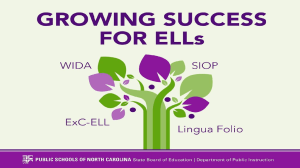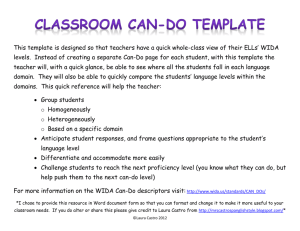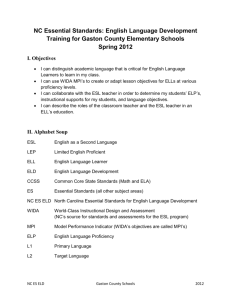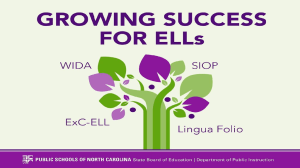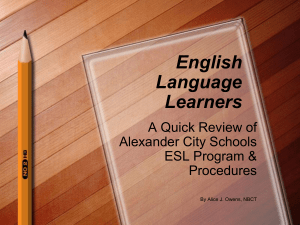Digging Deeper Into WIDA - Days 1, 2, & 3
advertisement
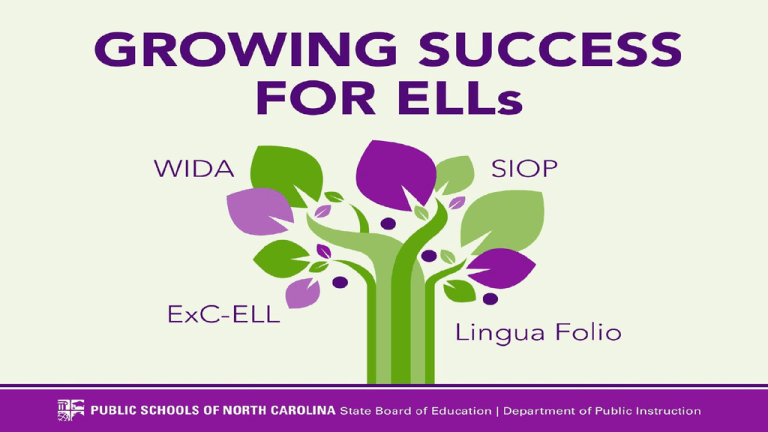
Introductions Kelsie Berg, former ESL/ SIOP Coach bergkelsie@hotmail.com Revae Bostwick, ESL Lead Teacher revae_bostwick@nccs.k12.nc.us Nadja Trez, DPI Consultant nadja.trez@dpi.nc.gov Let’s Put Our Thinking Caps On! 1) Grab a notecard from the center of your table. 2) Think independently about language development. 3) Choose one word to represent your thoughts about language development. 4) Write your word on your notecard. Let’s Move It! With notecard in hand, get up and choose your favorite sport (or one you hate the least). Once you’re in your corner, divide yourselves into groups of 3-5. Go with your group to a “private” area and construct a sentence to share with the whole group about language development using each of your words from the notecards. Sharing our Thoughts Let’s hear your thinking! Today’s Objectives 1. Interpret WIDA’s Guiding Principles of Language Development. 2. Utilize WIDA’s Can Do Philosophy to evaluate our own districts. 3. Understand sociocultural contexts. 4. Evaluate use of academic/disciplinary language and academic conversations in the classroom Logistics * restroom locations * wifi passwords * group norms * daily schedule on next slide Today’s Agenda 7:30 - 8:30 Registration/Breakfast 8:30 - 10:00 Opening Session 10:00 - 10:15 Break 10:15 - 11:15 Concurrent Sessions 11:15 - 12:15 Lunch 12:15 - 2:15 Concurrent Sessions 2:15 - 2:30 Break 2:30 - 4:00 Concurrent Sessions Schedule Overview Day 1 Discuss WIDA’s Guiding Principles and Can Do Philosophy Using Academic Language in Sociocultural Contexts Day 2 Differentiating Language for Various English Language Proficiency Levels Evaluating Formative Assessments Day 3 Analyze Data and Design Actions Based on Data Implications Collaboration and Implementing the Smartest Plan What’s your confidence level? www.plickers.com What is WIDA? • • • • • • • • • Guiding Principles Can Do Philosophy Can Do Descriptors Academic Language Sociocultural Context Performance Definitions Proficiency Levels ELD Standards MPIs & Their Components source: www.wida.us What is WIDA? Each participant has a blue question card or a yellow card containing a response. Find your match and line up in 2 parallel linesquestions on one side, answers on the other. ^_^ WIDA’s Guiding Principles of Language Development Participant 1 reads the card. Participant 2 responds to the card. Participant 3 adds an additional response. Participant 4 summarizes what has been said. (Add additional responses before the summary as needed based on the number at your table.) Reflection Which one resonated with you? Any anecdotes to share? What is something you feel we should share with our colleagues? WIDA’s Can Do Philosophy What are we doing well? Empowers: ❏ Linguistically diverse students & peers ❏ Families ❏ Communities ❏ Educators ❏ Administrators ❏ Researchers & Policymakers Where can we improve? Sociocultural Contexts Understanding vocabulary: ★ execubabble ★ Edward Cullen ★ laundry limbo ★ Lebron James Sociocultural Contexts Why and how does language change when used in various contexts? Sociocultural Contexts Volunteers??? “it is the differences in the ways people use language to accomplish goals and conduct their relationships that may have the most powerful consequences for student interactions in the classroom” source: WestEd Academic & Content Language Academic Language Instruction https://vimeo.com/47315992 High School Example WIDA Consortium How would you describe this if…. What are the characteristics of disciplinary language? Padlets for Academic Language Language of Language Arts: http://padlet.com/revae_bostwick/so764krslczt Language of Math: http://padlet.com/revae_bostwick/moc9ffe4fj3o Language of Science: http://padlet.com/revae_bostwick/uj569h8rtzn0 Language of Social Studies: http://padlet.com/revae_bostwick/ihse7fjci0wt Language of English Language Arts Grades K - 2 ● ● Phonics & Phonemic Awareness Letter & Word Recognition Grades 3 - 12 ● ● ● ● ● ● Explicit, intensive systematic instruction on complex vocabulary Reading strategy instruction Genre text instruction Repeated readings Constructive feedback Structured academic discussion opportunities OTHER LINKS: Common Core Standards 40 Ways to read like a detective Language of Math OTHER LINKS: http://dpi.wi.gov/math/disciplinary-literacy Common Core 8 Practices MATH What would cause difficulties for Level 3 - 4 ELLs? Language of Science OTHER LINKS: ASCD site California State University site Language of Social Studies OTHER LINKS: Wisconsin State site What may be missing? * presentation orally & in writing * content context * frequent exposure and practice over a long period of time * conversation practice with learners w/higher language skills * scaffolding * rigorous academic language (“juicy text”) * constructive feedback on language development An Example of Prioritizing Vocabulary Take the EOG/ EOC question stems of released tests. http://www.ncpublicschools.org/accountability/testing/releasedforms?&print =true Copy and paste them into Wordsift or Wordle. http://wordsift.com/visualize Evaluate the bigger words for their “bang for the buck” value. Make these Tier 2 words a priority by grade level, school, content area, etc. ● Achieve the Core - copy and paste text into filter for Tier 2 words www.achievethecore.org A Reflective Moment What about WIDA has been an important reminder or “aha” for you today? Q & A; Wrap-up Day 2 Day 1 Discuss WIDA’s Guiding Principles and Can Do Philosophy Using Academic Language in Sociocultural Contexts Day 2 Differentiating Language for Various English Language Proficiency Levels Evaluating Formative Assessments Day 3 Analyze Data and Design Actions Based on Data Implications Collaboration and Implementing the Smartest Plan Today’s Agenda 8:00 - 10:00 Concurrent Sessions 10:00 - 10:15 Break 10:15 - 11:15 Concurrent Sessions 11:15 - 12:15 Lunch 12:15 - 2:15 Concurrent Sessions 2:15 - 2:30 Break 2:30 - 4:00 Concurrent Sessions Unfinished Business from Yesterday •Ideas for using WIDA tools to make RTI decisions for struggling students •Reconciling gap between ACCESS scores, academic performances, and EOG scores, AMAOs, and whether or not someone gets mods and explaining to classroom teacher •Is push-in an acceptable method for ELL instruction? •K-6 WIDA lesson plans Today’s Objectives 1. Implementing academic conversations into lessons 2. Review the ELD Standards and Performance Definitions 3. Differentiation for ELLs based on language proficiency level by constructing MPIs 4. Evaluate formative assessments Academic Language and Literacy http://www.jeffzwiers.org/index.html Math Paired Conversation Protocol http://www.jeffzwiers.org/interaction.html Structured Conversation Practice http://www.jeffzwiers.org/interaction.html Conversation Analysis Tool 1. Do conversation turns build on previous turns to build up an idea? 2. Do conversation turns focus on the knowledge or skills presented in the objectives? Rating Criteria: 4 - ½ or more turns do so clearly & concisely 3 - ½ or more turns do, but not clearly 2 - few turns do 1 - no turns do adapted from the work of Kenji Hakuta, Jeff Zwiers and Sara Rutherford-Quach, Stanford University What from the “Constructive Conversation Skills Poster” could we incorporate for an academic conversation in science? ONLINE RESOURCES •ASCD ELL Resources •Scholastic Teacher Resources •Cathy’s ESL Symbaloo •Writing Activities •Reading Activities •Speaking Activities •Listening Activities •Duolingo •Flocabulary How do the pieces fit together? What image symbolizes the way you see WIDA Standards, College & Career Ready Standards, and Academic Language blending/fitting together? ** take some time to process this & then work with a group of 3 - 4 people to come up with an image that represents the way in which you see them all fitting/working together Elements of WIDA WIDA ELD Standards So many layers to consider! WIDA’s ELD Standards Proficiency Levels Performance Definitions At a given proficiency level, what the ELL student will process, understand, produce, or use. (Page RG44 in the 2007 Edition) Speaking Rubric Found on p. RG-55 in the Resource Guide of the 2007 WIDA Standards handbook. This is the rubric that WAPT and ACCESS administrators should be utilizing to evaluate responses. Writing Rubric Found on page RG-56 in the 2007 WIDA Handbook Resource Guide. ACCESS writing domain is evaluated via this rubric. Upon Review of the Rubrics…. DISCUSS: 1. What is the purpose of the rubrics? 2. How are these useful and how do you use them in your districts? 3. What are the implications for ELLs? please discuss & then share out your table responses in a few minutes. New Performance Definitions Receptive Productive p. 8 in 2012 version p. 9 in 2012 version Your Turn! Take the speaking and writing performance definition elements and arrange them appropriately according to proficiency level. Vocabulary Usage (Specificity of word or phrase choice) • • • • • General, specific, and technical language Multiple meanings of words and phrases Formulaic and idiomatic expressions Nuances and shades of meaning Collocations Tiered Vocabulary •Move from general language to specific language to specialized or technical language. Standard Grade Level Cluster Language Specific Language Technical Language Mathematics 1-2 in all total sum Language Arts 3-5 person character protagonist Science 6-8 knee kneecap patella Social Studies 9-12 people population demographics Language of General Linguistic Complexity vs Language Forms & Conventions DISCOURSE LEVEL Linguistic Complexity ★ ★ ★ ★ ★ * quality & variety of oral and written text amount of speech/written text structure of speech/written text density of speech/written text organization & cohesion of ideas variety of sentence types SENTENCE LEVEL Language Forms & Conventions * types, array, & use of language structures ★ types and variety of grammatical structures ★ conventions, mechanics, & fluency ★ match of language forms to purpose/perspective A Nursery Rhyme for Academia A young male human was situated near the intersection of two supporting structural elements at right angles to each other: said subject was involved in ingesting a saccharine composition prepared in conjunction with the ritual observance of an annual fixed-day religious festival. Insertion into the saccharine composition of the opposable digit of his forelimb was followed by removal of a drupe of genus prune. Subsequently the subject made a declarative statement regarding the high quality of his character as a young male human. Bringing together all the aspects of Academic Language Stepping up the language! Let’s practice! What are the instructional implications of moving students up the scale? Share challenges and celebrations of how you increase the use of the upper level academic language features. Can Do Descriptors • More specific to grade level than language performance definitions • Focus more on academic tasks • Detailed by language domain What are the instructional implications of utilizing the Can Do Descriptors? How do you use them? Implications for Instruction? Use Can Do Philosophy A Reflective Moment What has been an important reminder for you today? 2012 WIDA MPI Format (Overview) Our tool to optimize learning! How do we create an MPI? 3 components of an MPI * additional components from 2012 WIDA handbook Support Examples p. 11 in 2012 WIDA edition RG-21 in the 2007 version What is transformation? (in relation to an MPI) As the name implies, transformation simply means to change or convert something. And in the case of MPIs, transformation occurs when we change one or more of its three elements: the language function, the content stem, or the instructional supports to make it specific to our own use within our own lessons. Examples of transformed MPIs http://www.livebinders.com/play/play?id=1089921&backur l=/shelf/my Links to the Standards: Math ELA Science Social Studies What guides MPI construction? Process for Developing MPIs ALSO: Assessment & Feedback Practice & Application At your table discuss possible MPIs that could be created based on the following information & select 1 person from your table to share with the whole group. • • ELD Standard: Language of Science Content Standard: Explain why Earth sustains life while other planets do not based on their properties (including types of surface, atmosphere and gravitational force) and location to the Sun • • Cognitive Function: your choice Language Proficiency Level: Level 3 Work with a partner to develop a strand of MPIs. Links to NC Standards: Math Science ELA Social Studies http://www.jeffzwiers.org/tools--resources.html MPI Sharing Q & A; Wrap-up Day 3 Agenda 8:00 - 10:00 Concurrent Sessions 10:00 - 10:15 Break 10:15 - 11:15 Concurrent Sessions 11:15 - 12:15 Lunch 12:15 - 2:15 Concurrent Sessions 2:15 - 2:30 Break 2:30 - 4:00 Concurrent Sessions Day 3 Day 1 Discuss WIDA’s Guiding Principles and Can Do Philosophy Using Academic Language in Sociocultural Contexts Day 2 Differentiating Language for Various English Language Proficiency Levels Day 3 Evaluating Formative Assessments Analyze Data and Design Actions Based on Data Implications Collaboration and Implementing the Smartest Plan “Wants” from Day 2 •EOG Cut Scores Link •English Language Arts – Questions by Standard •Word Reference – online dictionary •Simplify Difficult Text with Rewordify •12 Powerful Words •Grades 9 – 12 ELA Academic Vocab Quizlet •Critical Words for Common Core – Marilee Sprenger Today’s Objectives 1. Evaluate formative assessments used in your district or classroom. 2. Analyze data and design actions based on data implications. 3. Discuss options for collaboration and develop a plan to increase implementation of WIDA ideals in your district. FORMATIVE ASSESSMENT Construct a circle map that gathers what you know about formative assessment as a table group. monitors student learning formative assessment In your table groups, assign sections of the article, “Formative Assessment: What Do Teachers Need to Know and Do?” by Heritage, share any reminders or new information with your group after reading and decide if this information should be added to your group’s circle map (in a different color). Share new/added info with the whole group. www.flareassessment.org Effective Use of Formative Assessment In order to use formative assessment effectively with ELLs, teachers must be cognizant of students’ needs in content area learning and language development. source: WestEd Laura Alvarez, Sri Ananda, Aida Walqui, Edynn Sato, Stanley Rabinowitz What types of formative assessments do you use? http://wvde.state.wv.us/teach21/ExamplesofFormativeAssessment.html Observations - keep a notebook of only observations 3 - 2 - 1 Exit Slips Reading Response Logs Questioning based on Bloom’s Taxonomy (Stick Pick App) Checklists based on Can Do Descriptors, Linguafolio, WIDA rubrics Self-evaluations Individual Whiteboards Are your formative assessments IDEAL? I - Integrated D - Dynamic E - Enlightening A - Attainable L - Linked source: Wisconsin Center for Education Research (FLARE) www.flareassessment.org Take a moment to evaluate your formative assessments using the IDEAL Formative Assessments Rating Tool. Now What? What realizations did you come to after evaluating your formative assessments? What resources do you need to help you incorporate IDEAL formative assessment? Revisit Your MPIs Based on your reminders about formative assessment, brainstorm some authentic ways to assess your MPI strand. I am…. poem Let’s examine the data Data and Its Purpose The ultimate purpose of this data collection and reporting is to inform decisions that will improve education and achievement of children. Schmoker (2003) writes: “...the real work of instructional improvement [is] the collaborative effort to share, produce, test, and refine lessons and strategies targeted to areas of low performance, where more effective instruction can make the greatest difference for students.” Data Analysis Sequence Guidance for the Data Analysis Process Step 1: Pose Q(s) - What questions will be addressed? Step 2: Slice and visualize - How will the data be visualized? Step 3: Observe - What does the data reveal? Step 4: Hypothesize - What meaning does the data have? Step 5: Strategize - What actions will be taken? What were the steps again? Step 1= Step 4= Step 2= Step 5= Step 3= My Question (purpose): What areas should I target to better facilitate language development for my 4th grade students? scale score growth 1. What is the purpose of analysis? 120 2. What data do we have? 100 80 3. What patterns do we see in the data? 60 40 Series1 20 Series2 0 Series3 1 2 3 4 5 6 7 -20 -40 -60 -80 -100 Student "Name" 8 9 10 Series4 4. What questions and assumptions are raised by our data? 5. What might be contributing to these patterns? 6. What steps might we take to combat these potential contributing factors? Subject Subject Subject EOG Scores from 3 different schools GRADE 5th Science Reading Math GRADE 5th Science Reading Math GRADE 5th Science Reading Math 1 3 8 2 1 3 5 2 1 5 6 3 1. What is the purpose of analysis? 2 8 4 4 EOG SCORE 3 1 1 1 4 3 2 8 5 2 0 2 2 4 3 2 EOG SCORE 3 0 1 1 4 4 2 5 5 0 0 1 2 4 3 3 EOG SCORE 3 1 2 4 4 3 1 2 5 0 0 1 2. What data do we have? 3. What patterns do we see in the data? 4. What questions and assumptions are raised by our data? 5. What might be contributing to these patterns? 6. What steps might we take to combat these potential contributing factors? Hypothesis: ● What is one hypothesis we could make based on this data? Strategy: • What is a strategy that could be incorporated based on your hypothesis? It’s Data Time! How would you apply the same process to analyze data from YOUR district or school? What would your findings be? • What would your strengths be? • Which content areas are weaker than others? • Are your students better at academic vocabulary than language forms and conventions? • What types of professional development should you provide your teachers or administrators this year? • What strategies should you implement to improve any weak areas? ACCESS LISTENING & READING RESULTS Student “Name” Soc & Inst 1 100% 2 Lang. Arts Math Science Soc. St. 50% 75% 44% 55% 100% 50% 58% 33% 67% 3 100% 92% 75% 89% 89% 4 50% 25% 33% 55% 44% 5 83% 83% 83% 67% 67% 6 100% 58% 83% 44% 78% 7 83% 78% 100% 100% 83% 8 83% 75% 50% 44% 78% Indicates % correct on the ACCESS assessment by subject area Scores for Individual Students WIDA Data Dashboard scale score growth Review of data & its implications Information about student background, including linguistic and content abilities, is key to plan and deliver instruction to optimize opportunities for learning. (Tomlinson, 2003; Fairbairn & Jones-Vo, 2010). Building Blocks How can data discoveries influence our practice? Stop and Jot How has the awareness reached through data analysis shifted your perspective when looking at MPIs and formative assessment? Has it? Why or why not? Turn and Talk from Your Stop and Jot! Bringing It All Back Home Activity - 15 Essential Actions Individual Reflection Time with the Essential Actions * Each person chooses at least 2 actions and writes responses to the guiding questions for the essential actions. ACTION 1 Guiding Questions 1. How do the resources and experiences of students impact their engagement with the curriculum and their learning? 2. What might you do to learn more about students’ resources and experiences? 3. What are some examples of how you might incorporate students’ resources and experiences into the curriculum? Participant Response So . . . • What stood out to you in your reflection? • What are the implications? • What action is needed? A Huge Responsibility for ALL! Academic achievement—for all students—requires mastering academic language, and since students are primarily only exposed to the academic language of science, or social studies, or any other content area in those classes, this emphasizes the imperative that all teachers are responsible for helping students develop academic language in their own subjects. It’s not going to happen elsewhere. Collaboration Is Key! How do you currently collaborate with your colleagues to meet the needs of your ELLs? Schoolnet Resources https://buncombe.powerschool.com/ad min/home.html “Can Do” Sharing http://widaatwcer.blogspot.com/2012/05/can-do-descriptors-in-grades-3-5.html We are all language teachers! “Language and the Common Core State Standards” Leo van Lier, Monterey Institute of International Studies Aída Walqui, WestEd 1. Read your section (assigned by table) of the article. 2. Decide as a table group the 3 most important ideas from your section. 3. Share these ideas (referencing the paragraph/ page #) with the whole group. Justify why your table considers these the most important ideas. What might you need to share or remind your district of from the article? Our Past Three Days- What Now? • WIDA • MPIs • Formative Assessment • Data revelations • Academic Language • Can Do Philosophy Who, what, when, where, and how will these things be addressed in your district for the 2015-2016 school year? Ready, Set, Go! Time for ACTION! Let’s use- Action Plan: Creating a SMARTEST Plan to plan next steps. Final Thoughts Kelsie Berg, former Buncombe County SIOP Coach Revae Bostwick, Newton-Conover City Schools ESL Lead Teacher Nadja Trez, ESL DPI Consultant References Developing Content Area Literacy, http://www.sagepub.com/upm-data/34121_Section1.pdf Fillmore, L. W., & Snow, C.E. (2002) What Teachers Need to Know about Language Francis, D.J., Lesaux, N., Kieffer, M., & Rivera, H. (2006). Practical Guidelines for the Education of English Language Learners. Lemke, J.L. (1990). Talking Science: Language, Learning, and Values. Scarcella, R. (2003). Academic English: A Conceptual Framework Sato, Edynn. Language for Achievement. http://www.cde.ca.gov/sp/el/er/documents/achievementlang.pdf Walqui, A. (2003). Conceptual Framework: Scaffolding for English Learners. Zwiers, Jeff. Academic Language and Literacy. http://www.jeffzwiers.org/index.html Linguafolio self-assessmenthttp://esllfpilot.pbworks.com/f/LFGridNCES.pdf
